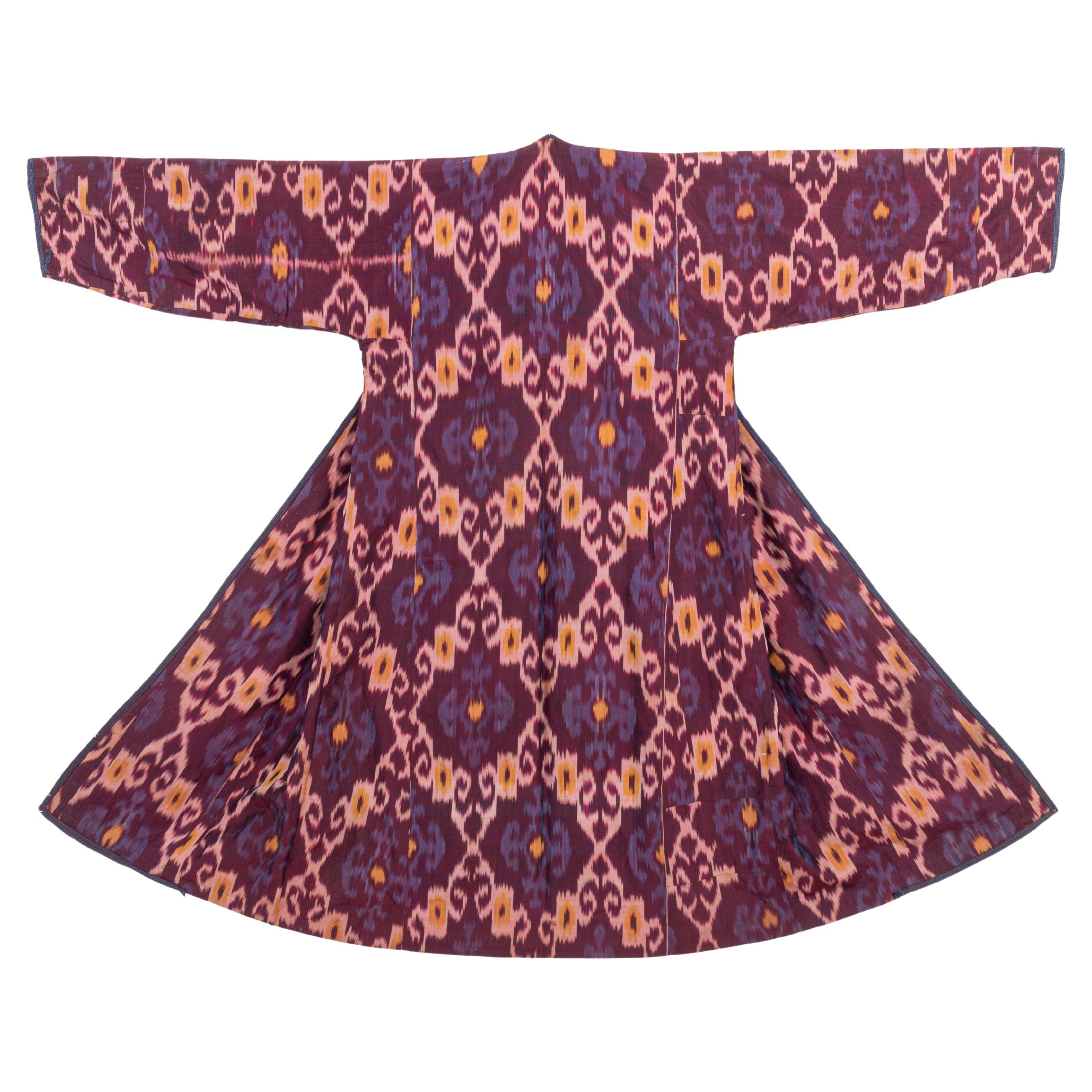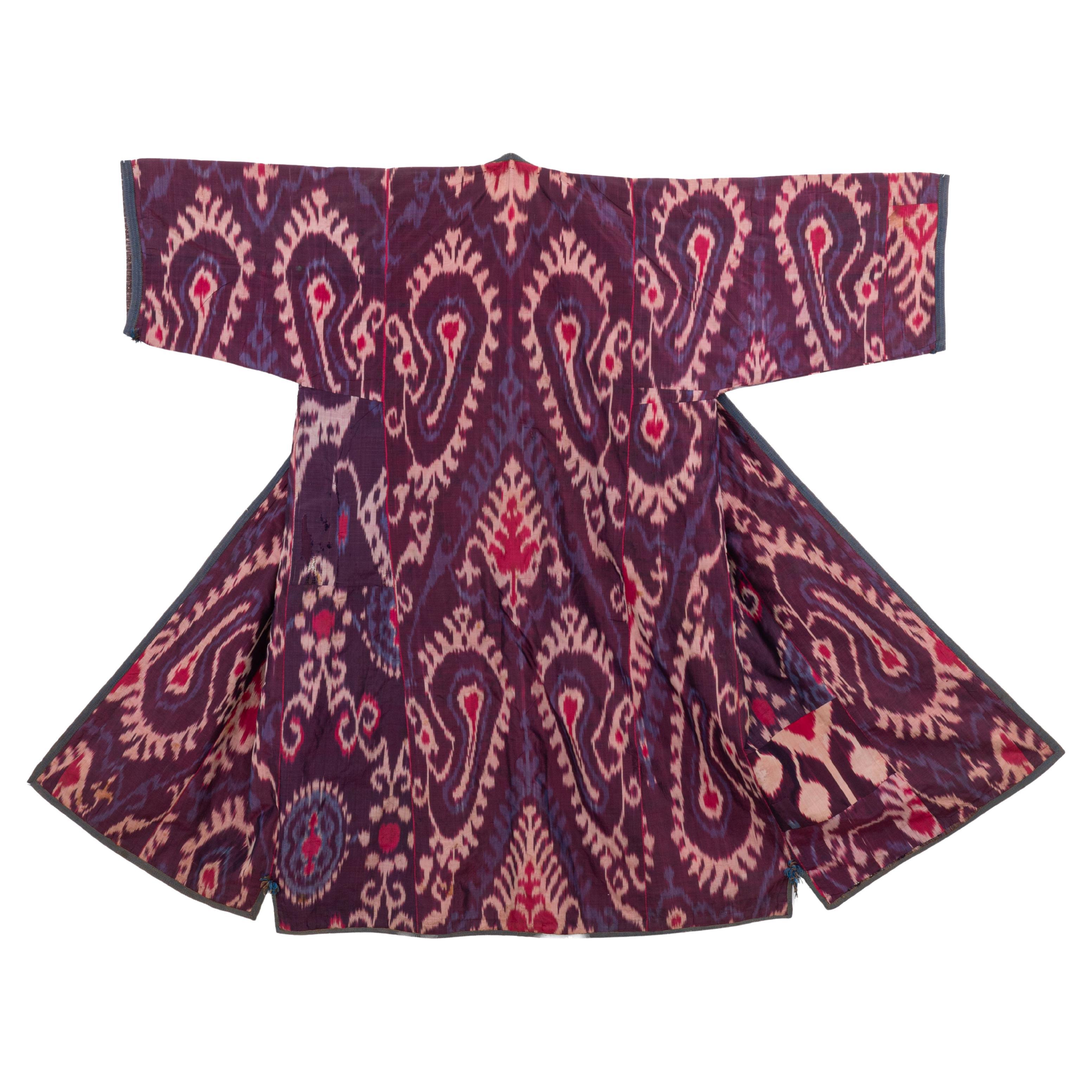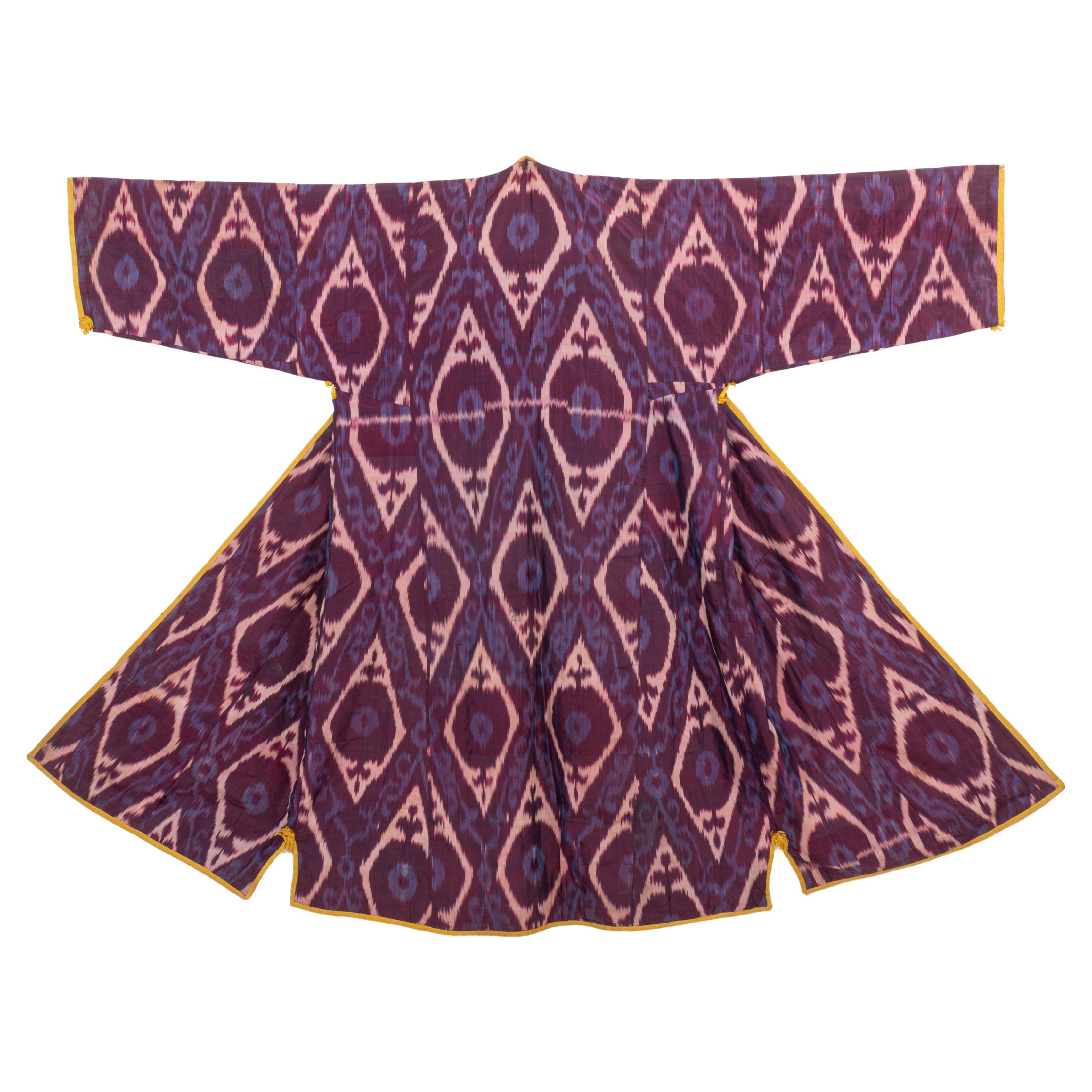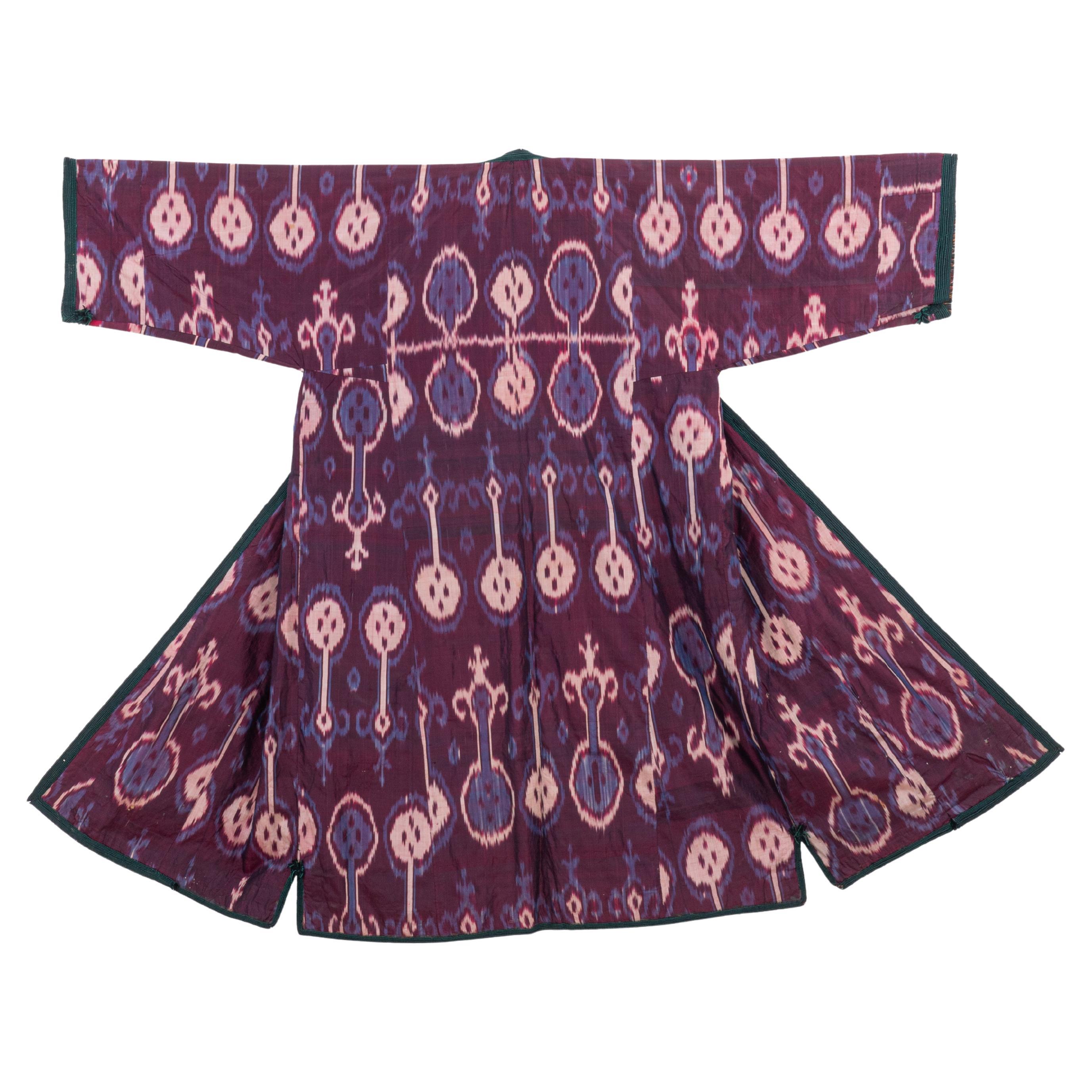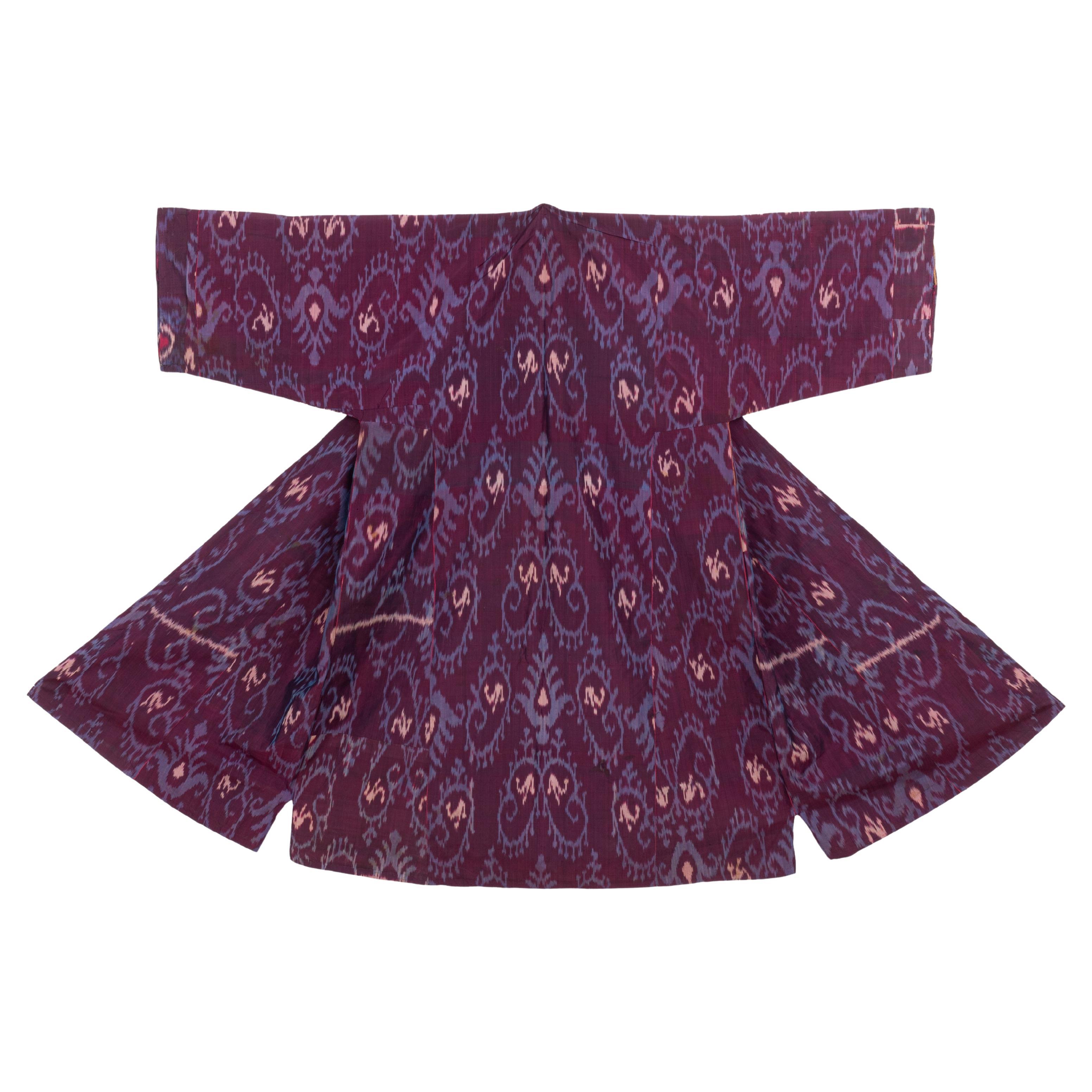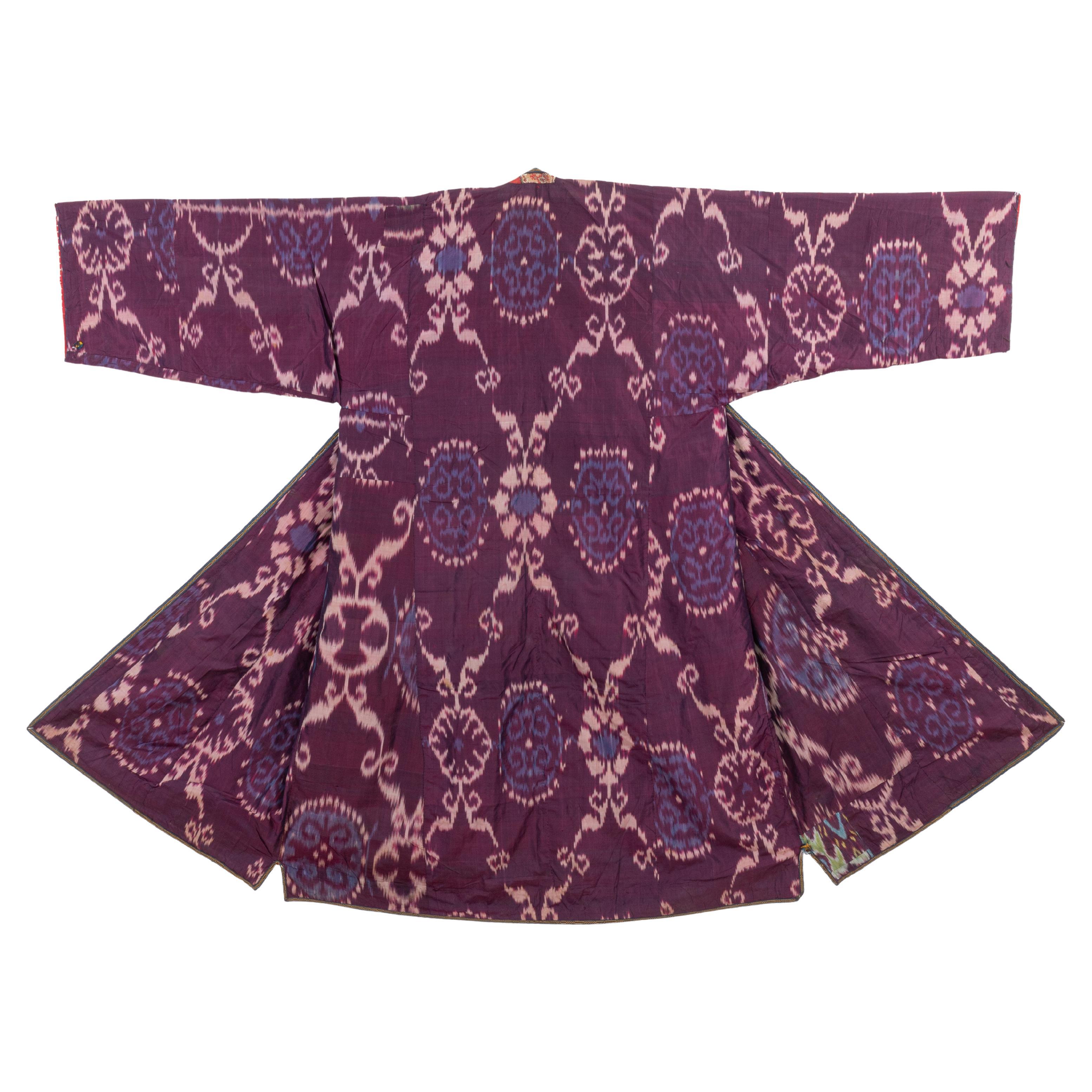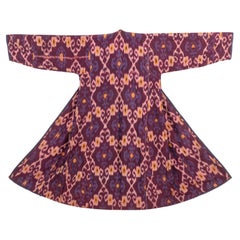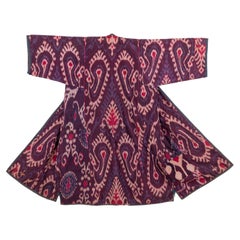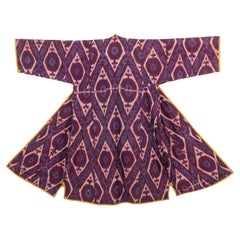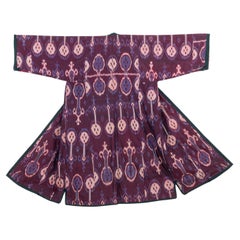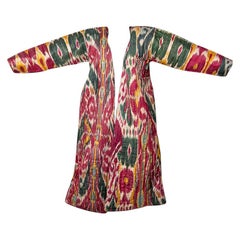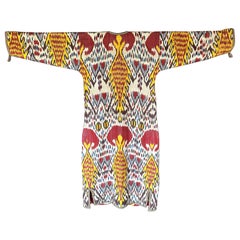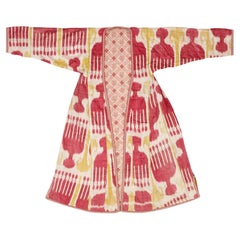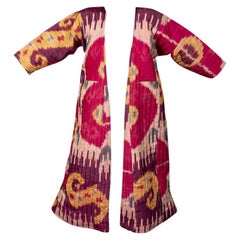Items Similar to Silk Ikat Chapan from Uzbekistan, Early 20th C
Want more images or videos?
Request additional images or videos from the seller
1 of 10
Silk Ikat Chapan from Uzbekistan, Early 20th C
$750
£568.60
€655.45
CA$1,056.25
A$1,171.31
CHF 615.44
MX$14,311.40
NOK 7,699.94
SEK 7,227.71
DKK 4,893.05
About the Item
A Silk Ikat Chapan from Uzbekistan is a traditional robe or coat made of silk fabric, adorned with intricate ikat patterns. "Ikat" is a dyeing and weaving technique used to create unique and vibrant patterns on textiles. Uzbekistan has a rich tradition of producing silk ikat fabrics, and the Chapan is a specific garment style commonly associated with the country.
The process of creating a Silk Ikat Chapan involves several stages:
1. Designing the pattern: The first step is to create the design for the Chapan. Traditional patterns often feature geometric shapes, floral motifs, and abstract designs. These patterns are meticulously planned and may be passed down through generations or inspired by cultural heritage.
2. Ikat dyeing: The silk threads are prepared for the ikat dyeing process. The desired patterns are carefully marked on the threads using a resist material, such as wax or tightly tied bindings. The marked threads are then dyed using natural or synthetic dyes, with each color applied separately. The resist material prevents the dye from reaching certain areas, creating a distinct pattern.
3. Weaving the fabric: After the threads are dyed and dried, they are woven on a loom to create the silk fabric. The weaver carefully aligns the dyed threads to ensure the pattern emerges correctly. The weaving process requires precision and skill to achieve the desired design.
4. Assembling the Chapan: Once the fabric is woven, it is cut and sewn into the shape of a Chapan. The Chapan typically has loose, flowing sleeves and a long length, often reaching the ankles. It is often embellished with decorative elements such as embroidery, beading, or tassels.
5. Finishing touches: The completed Chapan may undergo additional finishing touches, such as adding lining, fastenings, or other decorative elements.
Silk Ikat Chapans from Uzbekistan are highly regarded for their exquisite craftsmanship, vibrant colors, and intricate patterns. They are often worn on special occasions, ceremonies, and celebrations, showcasing the cultural heritage and artistic traditions of Uzbekistan. These garments not only serve as a form of personal expression but also as a symbol of the country's rich textile heritage and the skill of its artisans.
- Dimensions:Height: 47.25 in (120 cm)Width: 59.85 in (152 cm)Depth: 0.2 in (5 mm)
- Materials and Techniques:Silk,Ikat
- Place of Origin:
- Period:
- Date of Manufacture:1900s
- Condition:Wear consistent with age and use.
- Seller Location:Istanbul, TR
- Reference Number:Seller: 71631stDibs: LU1827334620762
About the Seller
4.9
Platinum Seller
Premium sellers with a 4.7+ rating and 24-hour response times
Established in 1987
1stDibs seller since 2016
1,393 sales on 1stDibs
Typical response time: <1 hour
- ShippingRetrieving quote...Shipping from: Istanbul, Turkey
- Return Policy
Authenticity Guarantee
In the unlikely event there’s an issue with an item’s authenticity, contact us within 1 year for a full refund. DetailsMoney-Back Guarantee
If your item is not as described, is damaged in transit, or does not arrive, contact us within 7 days for a full refund. Details24-Hour Cancellation
You have a 24-hour grace period in which to reconsider your purchase, with no questions asked.Vetted Professional Sellers
Our world-class sellers must adhere to strict standards for service and quality, maintaining the integrity of our listings.Price-Match Guarantee
If you find that a seller listed the same item for a lower price elsewhere, we’ll match it.Trusted Global Delivery
Our best-in-class carrier network provides specialized shipping options worldwide, including custom delivery.More From This Seller
View AllSilk Ikat Chapan, Tajikstan, Late 19th Century.
Located in Istanbul, TR
Chapans are probably the most famous Central Asian fashion garments made from mostly ıkats, either pure silk and lined with cotton, or silk war and cotton weft , again with a cotton ...
Category
Late 20th Century Tajikistani Folk Art Pillows and Throws
Materials
Cotton, Silk
Silk Ikat Chapan, Tajikstan, Late 19th Century.
Located in Istanbul, TR
Chapans are probably the most famous Central Asian fashion garments made from mostly ıkats, either pure silk and lined with cotton, or silk war and cotton weft , again with a cotton ...
Category
Late 20th Century Tajikistani Folk Art Pillows and Throws
Materials
Silk
Silk Ikat Chapan, Tajikstan, Late 19th Century.
Located in Istanbul, TR
Chapans are probably the most famous Central Asian fashion garments made from mostly ıkats, either pure silk and lined with cotton, or silk war and cotton weft , again with a cotton ...
Category
Antique Late 19th Century Tajikistani Folk Art Pillows and Throws
Materials
Cotton, Silk
Silk Ikat Chapan, Tajikstan, Late 19th Century.
Located in Istanbul, TR
Chapans are probably the most famous Central Asian fashion garments made from mostly ıkats, either pure silk and lined with cotton, or silk war and cotton weft , again with a cotton ...
Category
Antique Late 19th Century Tajikistani Folk Art Pillows and Throws
Materials
Silk
Silk Ikat Chapan, Tajikstan, Late 19th Century.
Located in Istanbul, TR
Chapans are probably the most famous Central Asian fashion garments made from mostly ıkats, either pure silk and lined with cotton, or silk war and cotton weft , again with a cotton ...
Category
Late 20th Century Tajikistani Folk Art Pillows and Throws
Materials
Cotton, Silk
Silk Ikat Chapan, Tajikstan, Late 19th Century.
Located in Istanbul, TR
Chapans are probably the most famous Central Asian fashion garments made from mostly ıkats, either pure silk and lined with cotton, or silk war and cotton weft , again with a cotton ...
Category
Antique Late 19th Century Tajikistani Folk Art Pillows and Throws
Materials
Silk
You May Also Like
Magnificent Silk Ikat Chapan, Uzbekistan, Xix Century
Located in San Pedro Garza Garcia, Nuevo Leon
Ikat Chapan – a man’s uzbek coat – Style Robe with exceptionally rich colour and dynamic pattering. Viewers may become lost in this ikat’s intertwining mot...
Category
Antique 19th Century Uzbek Antiquities
Materials
Cotton
Vintage Woven Ikat Chapan Robe Central Asia Uzbekistan
Located in Atlanta, GA
Chapan is the iconic front-open flowing robe traditionally worn by the nomadic people in Central Asia. In countries like Uzbekistan, it was almost the old national costume. This Uzbe...
Category
Early 20th Century Uzbek Tribal Textiles
Materials
Cotton
20th Century Uzbek Cotton and Silk Ikat Chapan Robe
Located in London, GB
20th century Uzbek cotton and silk ikat chapan robe
Uzbekistan, 20th Century
Height 122cm, width 153cm
Historically, an ikat chapan robe was a status symbol worn by nomadic tribes and settles in Uzbekistan as well as other Central Asian regions. Paired with belt, tunic, and trousers, the brightness of colours and intricacy of the embroidery were indicators of the wealth of the wearer.
The robe in Mayfair Gallery’s collection is brightly coloured with large, red and yellow geometrical patterns on a cream-coloured base. The inside of the robe is also patterned, with red floral motifs formed in a geometrical and symmetrical pattern.
The outside trim of this silk and cotton ikat chapan robe is elegantly embroidered with white and red patterns. Such embroidery carried symbolic meaning, protecting the wearer from evil spirits. The long sleeves are a beautiful design feature, intending to cover the wearer’s hands and protect them from cold temperatures.
Worn by both men and women, this eye-catching Uzbek robe...
Category
20th Century Uzbek Folk Art Textiles
Materials
Textile
Beautiful Ikat Munisak, Uzbekistan, 19th Century
Located in San Pedro Garza Garcia, Nuevo Leon
A beautiful Ikat Munisak – a woman’s uzbek robe – in traditional pomegranate design symbolizing fertility. It has a square patch in Magenta with a flower mo...
Category
Antique 15th Century and Earlier Asian Antiquities
Materials
Cotton
Antique Ikat Dyed Uzbek Silk Robe
Located in Delray Beach, FL
Beautiful bright and colorful Antique Ikat silk Dyed Uzbek Robe. Has minor wear and tear shown in photos. Colors: Fuchsia, light pink, purple, yellow and bl...
Category
Vintage 1920s Uzbek Textiles
Materials
Silk, Cotton
$450 Sale Price
35% Off
Late 19th Century Silk Ikat Uzbekistan Tribal Weaving
Located in New York, NY
Gorgeous handwoven silk Ikat weaving in rich magenta, gold and purple color, circa late 19th-early 20th century, Uzbekistan, Central Asia, on the ancient...
Category
Antique Late 19th Century Uzbek Tribal Tribal Art
Materials
Silk
More Ways To Browse
Ikat Fabrics
Antique Silk Fabric Silk
Antique Silk Fabric
Ikat Silk
Ikat Weavings
Antique Silk Tassel
Antique Silk Tassels
Antique Ikat Fabric
Ikat Robe
Uzbek Robe
Silk Chapan Robe
Porcelain Toads
Swat Pakistan
Swat Valley Furniture
Swat Valley
Turkish Embroidered Silver Thread
Brunschwig And Fils Pillow
Hermes Finesse
